A
-
ALABASTRON
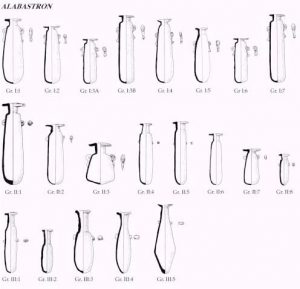
Definizione EN
The alabastron (pl. alabastra) is a long-bodied vessel, with a flat disk for the mouth and a rounded bottom. It is handleless, although some examples have eyes or lugs by which thread could be attached. The shape has a long history in Corinth, but is only preserved in Athenian pottery from the mid-sixth century. Examples of the shape have been found in a range of materials, including alabaster. The Greek term for this stone – alabastron (probably of Egyptian origin) – probably reveals the inspiration for the shape, and many examples are covered with white-ground, as if to imitate the stone. It seems primarily to have been a vessel for perfumed oil, as indicated by scenes on vases depicting it in use, e.g., by women after bathing.
Definizione IT
L’alabastron (pl. alabastra) è un vaso lungo, con un disco piatto per l’imboccatura e un fondo rotondo. È privo di manici, anche se alcuni esempi presentano linguette a cui si possono attaccare dei fili. Questa forma ceramica ha una lunga storia a Corinto, ma viene preservata nella ceramica ateniese solo dalla metà del sesto secolo. Esempi di alabastron sono stati trovati in una varietà di materiali diversi, alabastro incluso. Il termine greco per questa pietra – alabastron (probabilmente di origine egizia) – potrebbe rivelare l’ispirazione per la forma corrispondente, infatti molti esempi sono coperti con fondo bianco, come per imitare la pietra. Sembra che l’alabastron sia stato primariamente un recipiente per olio profumato, come indicato da scene sui vasi raffigurandolo in uso, ad es. di donne dopo il bagno.
Fonte
Beazley Archive
-
ALABASTRO
Definizione EN
–
Definizione IT
Roccia sedimentaria a struttura fibrosa e fibroso-raggiata, compatta, traslucida, a zone concentriche spesso diversamente colorate (dal bianco al giallo-bruno), esistente in due differenti tipi, l’a. gessoso o di Volterra, più tenero e meno pregiato, e l’a. calcareo o orientale (detto anche onice se recante zone a tinte molto distaccate); vengono entrambi usati come pietre da decorazione e per piccoli oggetti ornamentali.
Fonte
-
ANFORA
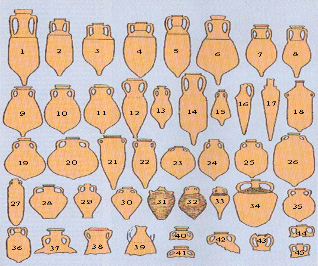
Definizione EN
The amphora (pl. amphorae; from Greek amphi – on both sides, phero – carry) is a two-handled pot with a neck that is considerably narrower than the body. It was used for the storage of liquids and solids such as grain. Undecorated ‘coarse’ amphorae, with their lower part tapering to a point, were the standard transport containers in the Mediterranean. They are frequently depicted in symposium scenes. Panathenaic prize amphorae are perhaps the closest in shape, but the majority of painted amphorae are grouped into two main types, the one-piece belly-amphorae, and neck-amphorae, which have a clearly-marked neck. Also discussed here is the pelike, another two-handled storage vessel.
Definizione IT
L’anfora (dal greco amphi – da entrambi i lati, phero– portare) è un grosso vaso con due maniglie e un collo decisamente più stretto del corpo, usato per il deposito di liquidi e alcuni elementi solidi come grano. Le anfore “grezze” non decorate, con la parte inferiore affusolata fino a un certo punto, erano i contenitori standard per il trasporto nel Mediterraneo. Questa forma ceramica raffigura spesso scene di simposio. Le anfore del premio panatenaico sono forse le più simili come forma, ma la maggioranza delle anfore dipinte sono raggruppate in due tipi principali, quelle standard, con profilo tra spalla e collo che segue una linea continua, e a collo distinto, con un collo molto marcato. In questa divisione rientra anche la pelike, un altro contenitore per lo stoccaggio.
Fonte
Beazley Archive
-
ARYBALLOS

Definizione EN
The aryballos (pl. aryballoi) has a small round or ovoid body and a narrow neck. The typically broad and flat lip prevents spillage. The use of the Greek term aryballos for this particular shape is a modern convention. It may well have been used in antiquity, but we know that other names, such as lekythos, were also applied.
Aryballoi are common in Corinthian ware, some being tiny and meticulously decorated. Examples are less widespread in Athenian, although the shape is depicted on vases or funerary stelai.
In Corinth and East Greece, warrior’s heads, animals, and other mould-made figures could serve as the body of aryballoi. Athenian potters sustain the habit, and there are examples in the form of female heads, shells, even genitals.
Definizione IT
L’aryballos (pl. aryballoi) ha un corpo piccolo, rotondo o ovoidale, e un collo ristretto. L’orlo tipicamente ampio e piatto serve a prevenire la fuoriuscita del liquido. L’uso del termine greco aryballos per questa forma specifica è una convenzione moderna. Potrebbe essere stata usata nell’antichità, ma sappiamo che venivano utilizzati anche altri nomi, come lekythos. Gli aryballoi sono comuni nella ceramica corinzia, alcuni di essi sono molto piccoli e decorati meticolosamente. Meno diffusi sono gli esempi in quella ateniese, anche se la stessa forma viene dipinta su vasi o stelai funerarie. Nella Grecia corinzia e orientale, teste di guerriero, animali e altre figure fatte con fango potevano servire come corpi di aryballoi. Anche tra i vasai ateniesi ci sono esempi di aryballoi con forma di teste femminili, conchiglie e addirittura genitali.
Fonte
Beazley Archive
B
-
BRONZO
Definizione EN
–
Definizione IT
Categoria di leghe metalliche in cui entrano come componenti principali il rame (in proporzione superiore al 70%: fra l’85 e il 90%, per es., il b. statuario), che conferisce malleabilità alla lega, e lo stagno, che le conferisce durezza, mentre piccole quantità di altri elementi le attribuiscono proprietà particolari
Fonte
–
-
BUCCHERO
Definizione EN
–
Definizione IT
Vaso o altro oggetto fatto di bucchero. I buccheri, importati in Italia dal Portogallo, furono di gran moda nel sec. 17°; e quando, circa nello stesso tempo, s’iniziarono gli scavi delle necropoli etrusche e vennero alla luce in gran copia vasi caratteristici di un’argilla nerastra lucidata, essi vennero indicati con lo stesso nome.
Fonte
–
C
-
CERAMICA
Definizione EN
–
Definizione IT
Arte e tecnica, ormai largamente automatizzata e industrializzata, di fabbricare, partendo da minerali incoerenti di tipo argilloso, oggetti plasmati (a mano o a macchina) che, previo essiccamento, vengono resi resistenti mediante cottura in appositi forni e che, a seconda dei materiali di partenza e delle modalità di fabbricazione, prendono i nomi di laterizî, terrecotte, maioliche, terraglie, grès, porcellane.
Fonte
–
-
CHOUS

Definizione EN
Name of a type of pot-bellied oinochoe with a trilobed mouth and a low foot. It was used on the day of the choes (celebration of the jugs), the second day of the Anthesteria, an Athenian celebration for Dyonisus.
Definizione IT
Nome dato a un tipo di oinochoe panciuta a bocca trilobata e basso piede che veniva utilizzata nel giorno delle choes (festa delle brocche), il secondo giorno delle Antesterie,
una festa ateniese in onore di Dioniso
Fonte
ICCD
-
CORINZIA
Definizione EN
From the VIII century BC, Corinth became one of the most active centers of Greece for the production and the export of ceramic pottery.
Corinthian workshops use a characteristic pale yellow clay, highly purified, decorated at first in geometric style.
Already in the last decades of the VIII century BC, thanks to the rapid assimilation of the decorative and iconography motifs coming from the eastern Mediterranean, Corinthian painters develop a figurative style characterized by real and imaginary animals, by narrative scenes also mythological alternate on the body of the vase with exquisitely decorative elements such as braids, lotus flowers and palms.
The technique used is that of the black silhouette on a light background of the clay; the internal details of the figures are outlined through the incision and through the adoption of added colors such as red, purple and white.
Definizione IT
Dall’VIII secolo a.C., Corinto è diventato uno dei centri più attivi per produzione ed esportazione di ceramic pottery. I laboratori corinzi usano un’argilla particolarmente pallida e gialla, altamente purificata, decorata prima in stile geometrico. Già nelle ultime decadi dell’VIII sec. a.C., grazie alla rapida assimilazione dei motivi decorativi ed iconografici provenienti dal Mediterraneo orientale, i pittori corinzi sviluppano uno stile figurativo caratterizzato da animali reali e immaginari, scene narrative anche mitologiche alternate sul corpo del vaso con elementi squisitamente decorativi come trecce, fiori di loto e palme. La tecnica utilizzata è quella delle figure nere sullo sfondo chiaro dell’argilla; i dettagli interni delle figure sono delineati tramite incisione e l’adizione di colori aggiunti come rosso, viola e bianco.
Fonte
Archaeological museum of Bologna
-
CORNIOLA
Definizione EN
–
Definizione IT
Varietà rossastra di calcedonio, semitrasparente o traslucida, talora zonata, usata come pietra semipreziosa
Fonte
–
-
CRATERE
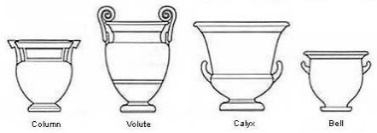
Definizione EN
The term ‘krater’ suggests a mixing-vessel (compare Greek kerannumi – to mix), and we know that the wine served at the symposium was mixed with water. On vases decorated with symposium-scenes, a large open container with a foot is often depicted, and the name krater is appropriate. Examples can be traced back to the large Geometric examples that were used as grave-markers, and this funerary connection continues to be important. Excavations of burial-sites have shown that they could be used in Greek settlements overseas as containers of ashes, and South Italian, especially Apulian, volute-kraters often carry explicit funerary iconography. In the Athenian repertoire, there are four main types identified today: column-, volute-, calyx- and bell-.
Definizione IT
Il termine “cratere” suggerisce un recipiente di miscelazione (cf. il greco kerannumi, mescolare), dal momento che il vino servito ai simposi veniva mescolato con l’acqua. Sui vasi decorati con scene simposiali, viene raffigurato un contenitore largo e ampio con un piede, e il nome cratere è appropriato per designarlo. Esempi di questo vaso possono essere ricondotti agli esempi geometrici che venivano usati come lapide, e questa connessione con il mondo funerario continua ad essere importante. Scavi di necropoli hanno mostrato che i crateri potevano anche essere usati negli insediamenti greci oltremare come contenitori di ceneri, e del sud Italia, specialmente in Puglia, i crateri a a volute spesso portano un’iconografia esplicitamente sepolcrale. Nel repertorio ateniese, ci sono quattro tipi principali di crateri che vengono identificati oggi: “a colonnette”, “a volute”, “a calice” e “a campana”.
Fonte
Beazley Archive
E
-
ETRUSCA A FIGURE NERE
Definizione EN
The local production of Etruscan vases probably began in the 7th century BC. Initially, the vases followed examples of black-figure vase painting from Corinth and East Greece. It is assumed that in the earliest phase, vases were produced mainly by immigrants from Greece. The first major style was so-called Pontic vase painting. This was followed between 530 and 500 BC by the Micali Painter and his workshop. They mainly produced amphorae, hydriai and jugs. Depictions included komasts, symposia and animal friezes. Mythological motifs occur more rarely, but are already created with great care. By this time, Etruscan vase painting had begun to take its main influence from Attic vase painting. The black-figure style ended about 480 BC. In its final phase, it had developed a tendency to mannerism and a sloppy silhouette style of drawing.
Definizione IT
Come accadde nel resto del Mediterraneo, anche in Etruria le importazioni di oggetti ceramici si rivolsero, dal secondo quarto del VI secolo a.C., ai prodotti attici; il cambiamento nelle importazioni condusse ad un mutamento nelle imitazioni che si riferirono ai modelli della ceramica attica a figure nere a partire dal 550 a.C. circa, stando ai confronti stilistici con le opere ateniesi. All’interno di questa produzione si distinguono gruppi diversi: i vasi pontici, il Gruppo delle foglie d’edera, il Gruppo della Tolfa e il gruppo del Pittore di Micali. In generale i pittori etruschi a figure nere sono meno accurati nel disegno e la scarsa comprensione dei modelli cui si ispirano, sia per lo stile sia per i soggetti, li conduce ad esiti maggiormente decorativi. La qualità tecnica non raggiunge gli standard attici: vi è scarsa attenzione all’equilibrio delle forme e la cottura è diseguale. L’argilla va dal giallo grigio al rosa, la pittura varia nella tendenza al nero ed è piuttosto opaca. Questi prodotti sono stati solo raramente trovati al di fuori del territorio etrusco.
Fonte
–
-
ETRUSCA A FIGURE ROSSE
Definizione EN
An imitative adoption of the red-figure technique only developed in Etruria around 490 BC, nearly half a century after that style had been invented in Greece. Early produce is described as pseudo-red-figure Etruscan vase painting, due to its differing technique. Only by the end of the 5th century was the true red-figure technique introduced to Etruria. For both pseudo- and true red-figure, numerous painters, workshops and production centres have been recognised. Vases were not just produced for the local market, but also sold to Malta, Carthage, Rome and the Ligurian coast.] Only towards the end of the 5th century was the true red-figure technique, with the figures as reserved areas remaining in the actual clay colour, introduced to Etruria. The first such workshops developed in Vulci and Falerii, but also produced for surrounding areas. The original workshops were probably founded by Attic masters, but the early vessels also already display a South Italian influence. These workshops dominated the Etruscan market until the 4th century BC. Large and medium format vessels like kraters and jugs were mostly decorated with mythological scenes. During the course of the century, the production of Falerii began to outclass that of Vulci in terms of quantity. New centres of production developed in Chiusi and Orvieto. Chiusi became especially important through the Tondo Group, which produced drinking cups with mostly dionysiac motifs on the inside. In the second half of the century, production moved to Volterra. Here, especially a certain type of craters, the kelebes were produced and initially painted very elaborately.
In the second half of the 4th century BC, mythological themes disappeared from the repertoire of Etruscan vase painters. They were replaced with women’s heads and figural depictions of not more than two persons. Instead, the vase bodies were now mostly covered with ornamental and floral motifs. Larger compositions now only occurred in exceptional cases, such as the amazonomachy on a krater by the Hague Funnel Group Painter. The initially, still substantial, production of Falerii lost its dominant role to the newly founded production centre at Caere. The Caere workshops were probably founded by masters from Falerii; they lacked a separate tradition but became the main centre of red-figure vase production in Etruria. Its standard repertoire included simply painted oinochoai, lekythoi and drinking cups (e.g. by the Torcop Group), and small plates (Genucuilia Group). By the end of the 4th century, a change in consumer tastes led to a shift towards the production of black-glazed ware, which marked the end of red-figure vase production in Etruria.
Definizione IT
Come accadde nel resto del Mediterraneo, anche in Etruria le importazioni di oggetti ceramici si rivolsero, dal secondo quarto del VI secolo a.C., ai prodotti attici; il cambiamento nelle importazioni condusse ad un mutamento nelle imitazioni che si riferirono ai modelli della ceramica attica a figure nere a partire dal 550 a.C. circa, stando ai confronti stilistici con le opere ateniesi. All’interno di questa produzione si distinguono gruppi diversi: i vasi pontici, il Gruppo delle foglie d’edera, il Gruppo della Tolfa e il gruppo del Pittore di Micali. In generale i pittori etruschi a figure nere sono meno accurati nel disegno e la scarsa comprensione dei modelli cui si ispirano, sia per lo stile sia per i soggetti, li conduce ad esiti maggiormente decorativi. La qualità tecnica non raggiunge gli standard attici: vi è scarsa attenzione all’equilibrio delle forme e la cottura è diseguale. L’argilla va dal giallo grigio al rosa, la pittura varia nella tendenza al nero ed è piuttosto opaca. Questi prodotti sono stati solo raramente trovati al di fuori del territorio etrusco.
Fonte
–
-
ETRUSCO-CORINZIA
Definizione EN
Etrusco-Corinthian pottery
The large amount of Corinthian vases exported in Etruria and southern Italy and the emigration of greek craftsmen determined, from about 630 BC, the birth of imitation local production of Corinthian pottery. Among these productions, called Italo-Corinthian, assumed a prominent role, for diffusion and artistic importance, the Etrusco-Corinthian one. In Etruscan centers arose in fact a numerous shops who produced thousands of vases that reproduce forms and decorative motifs of Corinthian models to which sometimes are mixed greek-oriental influences.
Definizione IT
La grande quantità di vasi corinzi esportati in Etruria e in Italia meridionale e l’emigrazione di artigiani greci hanno determinato, dal 630 a.C., la nascita dell’imitazione della produzione locale di ceramica corinzia. Tra queste produzioni, chiamate Italo-corinzie, ha assunto un ruolo importante, grazie a diffusione e importanza artistica, quella etrusco-corinzia. Nei centri etruschi, infatti, sono sorti numerosi shops che producevano migliaia di vasi che riproducevano forme e motivi decorativi di modelli corinzi a cui a volte sono mischiate influenze greco-orientali.
Fonte
Bologna Musei
-
ETRUSCO-GEOMETRICA
Definizione EN
The first contacts between the Greeks and the West become regular starting from the Eight century B.C. and are witnessed by a few coppe euboiche found in Veio and Ischia (the ancient Pithecusa. The second Greek colonization followed and one of the results of these contacts was the “”italo-geometrican ceramics””, class that refers to oggetti ceramici created in Italy and Sicily outside the Greek colonies whose decoration is in line with the Greek geometric style. The first example of this style was tracked back in Etruria, in Veio, Vulci and Tarquinia. For these productions it was coined the definition “”etrusco-geometric ceramics””, which refers to the vase production in Etruria, of geometric style, towards the end of the Eight Century B.C. to the fist half of the Seventh Century B.C., period of a subgeometric style mixed with oriental influences. Such products, sometimes distinguishable from the Greek ones through argilla, present a decoration di tipo euboico, while some shapes are typically indigenous like the anfora biconica (vedi civiltà villanoviana).
Definizione IT
I primi contatti dei greci con l’occidente diventano regolari a partire dall’VIII secolo a.C. e sono attestati da alcune coppe euboiche trovate a Veio e a Ischia (l’antica Pithecusa); seguì la seconda colonizzazione greca e uno dei risultati di questi contatti fu la «ceramica italo-geometrica», classe che si riferisce propriamente ad oggetti ceramici creati in Italia e in Sicilia al di fuori delle colonie greche e la cui decorazione risulta essere in linea con lo stile geometrico greco. Di questo stile, il primo esempio è stato rintracciato in Etruria, a Veio, Vulci e Tarquinia.[4] Per questi prodotti è stata coniata la definizione ceramica etrusco-geometrica che si riferisce alla produzione vascolare in Etruria, di stile geometrico, compresa tra il terzo quarto dell’VIII secolo a.C. e la prima metà del VII secolo a.C.,[5] periodo nel quale si trova uno stile subgeometrico ormai mischiato a influenze orientaleggianti. Questi prodotti, talvolta distinguibili dai prodotti greci solo tramite l’argilla, presentano una decorazione di tipo euboico, mentre alcune forme sono tipicamente indigene come l’anfora biconica (vedi Civiltà villanoviana).
Fonte
–
F
-
FIBULA
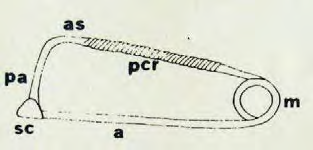
Definzione EN
Fibula, brooch, or pin, originally used in Greek and Roman dress for fastening garments. The fibula developed in a variety of shapes, but all were based on the safety-pin principle.
The Etruscans were fond of fibulae, some of which were very large and decorated with elaborate granulation and processions of animals done in relief. The Roman conquests spread the use of the fibula, which became the basis for more complicated brooches. By the Middle Ages the Roman safety-pin type of fibula had fallen into disuse.
Definzione IT
La fibula era originariamente usata nei vestiti Greci e Romani per assicurare gli indumenti. Essa si è sviluppata in una varietà di forme, tutte basate sul principio della spilla da balia. Gli Etruschi erano amanti delle fibule, di cui alcune erano molto grandi e decorate con una granulazione elaborata e processioni di animali in rilievo.
Fonte
Britannica
H
-
HYDRIA

Definizione EN
The hydria, primarily a pot for fetching water, derives its name from the Greek word for water. Hydriai often appear on painted Greek vases in scenes of women carrying water from a fountain, one of the duties of women in classical antiquity. A hydria has two horizontal handles at the sides for lifting and a vertical handle at the back for dipping and pouring. Of all the Greek vase shapes, the hydria probably received the most artistically significant treatment in terracotta and in bronze.
Definizione IT
L’hydria, primariamente un vaso per attingere aqua, trae il suo nome dalla parola Greca per acqua. Le hydriai spesso appaiono sui vasi greci dipinti in scene di donne che portano acqua da una fontana, uno dei doveri delle donne nell’antichità classica. Un’hydria ha due maniglie orizzontali ai lati per sollevare e una maniglia verticale sul retro per immergere e versare. Di tutte le forme di vasi greche, l’hydria ha ricevuto il trattamento più artisticamente significativo in terracotta e bronzo.
Fonte
The Metropolitan Museum of Art
I
-
INCENSIERE (THYMIATERION)
Definzione EN
Incense burners were popular items among the Etruscans, who often buried their dead with them. This example is typical of a type normally associated with Vulci, the site of extensive bronze-working activity throughout much of Etruscan history. A robust nude youth, a descendant of the Greek kouros type, stands on a triangular platform supported by a tripod with lion’s-paw feet. The shaft rising from his head terminates in a plant-like form that originally supported a small bowl for the incense.
Definizione IT
Gli incensieri erano popolari tra gli Etruschi, che spesso includevano questi oggetti nella sepoltura dei morti. L’esempio presente nel database è tipico di un tipo normalmente associato con Vulci, sito di un’estesa attività di lavorazione del bronzo per la maggior parte della storia Erusca. Un giovane nudo e robusto, discendente del tipo greco del kouros, è in piedi su una piattaforma triangolare supportata da tripode con piedi a zampa di leone. Lo stelo che sorge dalla sua testa termina a forma di pianta e originariamente supportava una piccola ciotola per l’incenso.
Fonte
The Metropolitan Museum of Art
K
-
KANTHAROS

Definizione EN
The kantharos (pl. kantharoi) is a deep vessel with two distinctive high handles. The stem of the foot is often tall. The form can be traced back to the eighth century, and kantharoi – perhaps metal versions- are frequently depicted on black- and red-figure vases, held by Dionysos or Herakles. Although the name is ancient (Greek kantharos – dung-beetle), it is not clear how precisely it was connected with this shape, and it seems that kotyle could have been used as well.
In the fourth century, the ‘cup kantharos‘ is common. Its handles project horizontally, and do not return to join the body.
Definizione IT
Il kantharos (pl. kantharoi) è un profondo contenitore con due manici distintivi per la loro altezza. La base del piede è spesso alta. La forma può essere ricondotta all’ottavo secolo, e i kantharoi – forse nella versione in metallo – vengono spesso raffigurati su vasi a figure nere e rosse tenute in mano da Dioniso o Eracle. Nonostante il nome sia antico (dal greco kantharos, scarabeo stercorario), non è chiaro come si colleghi esattamente a questa forma, e sembra che il kotyle potrebbe essere stato altrettanto usato. Nel quarto secolo, la ‘coppa kantharos‘ è comune. I suoi manici si proiettano in orizzontale, e non ritornano a ricongiungersi col corpo.
Fonte
Beazley Archive
-
KYLIX
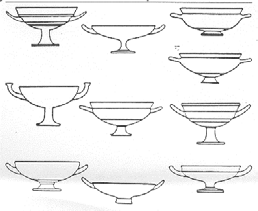
Definzione EN
Consistent features for drinking cups during the sixth to fourth centuries B.C. are the relatively shallow shape, a foot that is connected to the bowl by a stem (except in the case of stemless cups) and two handles. The Greek name kylix (pl. kylikes) seems to have been used for the shape in antiquity, although it was probably applied to other drinking vessels too. In particular, the kylix is used for the game of kottabos, which involved flinging the dregs of one’s drink at a target.
Definizione IT
Caratteristiche consistenti per coppe e tazze per bere dal sesto al quarto secolo a.C. sono la forma relativamente superficiale, un piede che è connesso al corpo con uno stelo e due manici. Il nome greco kylix (pl. kylikes) sembra essere stato utilizzato nell’antichità per questa forma ceramica, anche se probabilmente veniva applicato anche ad altri contenitori per bere. In particolare, la kylix viene usata per il gioco del kottabos, che consisteva nel colpire un bersaglio con il vino rimasto sul fondo della coppa.
Fonte
The Beazley Archive
L
-
LYDION
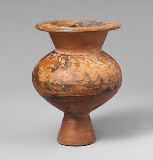
Definizione EN
–
Definizione IT
Presentava un corpo arrotondato con un ampio orlo a disco e un alto piede. La forma è nata in
Lidia in Asia Minore.
Fonte
–
N
-
NENFRO
Definizione EN
–
Definizione IT
Roccia vulcanica molto compatta e tenace, di colore grigio o rosso bruno, piuttosto diffusa nell’area laziale, considerata di natura tufacea; è un buon materiale da costruzione e come tale fu usato dagli Etruschi per opere di scultura e architettura.
Fonte
–
O
-
OINOCHOE
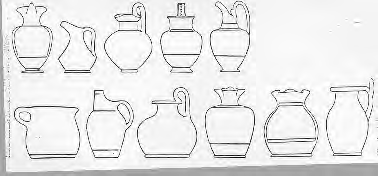
Definizione EN
The term oinochoe (pl. oinochoai; Greek oinos – wine and cheo – I pour) is appropriate to this shape and illustrations of it in use, and appears to have been used in antiquity. It is a single-handled vessel, usually taller than it is wide. Beazley identified ten types, based on variations of profile, mouth-type – such as trefoil (like an ivy leaf), round or beaked – and handle-form. One such is the chous (pl. choes), a plump shape with a smooth profile and trefoil mouth. Miniature versions are often found in children’s graves, invariably decorated with scenes involving young children. They were probably used in Athens during the Anthesteria. On the second day of the festival, named Choes, the newly-opened wine was drunk.
Definizione IT
Il termine oinochoe (pl. oinochoai, dal greco oinos, vino e cheo, versare) è appropriato per questa forma e illustrazioni dell’oggetto in uso, e sembra che sia stato utilizzato nell’antichità. Si tratta di un contenitore con un solo manico, di solito più alto che largo. Beazley ne ha identificati dieci tipi, basati su variazioni di profilo, tipo di becco – come a trifoglio, rotondo o beccato, e forma della maniglia. Un tipo di essi è il chous (choes). Versioni in miniatura sono spesso trovati nelle tombe dei bambini, invariabilmente decorate con scene che includono giovani. Erano probabilmente usati ad Atene durante l’Anthesteria. Il secondo giorno del festival, chiamato Choes, veniva bevuto il vino appena aperto.
Fonte
The Beazley Archive
-
OLPE
![]()
Definizione EN
The olpe (pl. olpai) is distinguished today from oinochoai. It is tall in relation to its breadth, with a smooth profile and a high handle. Examples occur from early on in black-figure. The name is ancient, but there seems to be little basis for applying it to this particular form. The ‘oinochoe of Type 8′ may also be called a mug in modern literature, after its spoutless rim and short size, and may have been used for drinking. Like other oinochoe-types, it may also have served as a measure.
Definzione IT
Oggi gli olpe (pl. olpai) vengono distinti dagli oinochoai. Si tratta di un vaso alto in relazione alla sua larghezza, con un profilo longilineo e una maniglia alta. Esempi accadono presto in figure nere. Il nome è antico, ma sembra che ci sia poca base per applicarlo a questa forma particolare. L”oinochoe di tipo 8′ potrebbe anche essere chiamato tazza nella letteratura moderna, dato il bordo senza beccuccio e la taglia piccola, e potrebbe essere usato per bere. Come altri tipi di oinochoe, potrebbe anche essere stato utilizzato come misura.
Fonte
–
P
-
PASTA VITREA
Definizione EN
–
Definizione IT
–
Fonte
–
-
PISSIDE

Definizione EN
Pyxes were small boxes of cylindrical shape with a lid, made of various materials, also valuable as ivory and silver. Initially intended to contain cosmetics, jewelry, toiletries and medicines, were later used in religious ceremonies, such as containers of relics or blessed hosts.
Definzione IT
La pisside era una piccola scatola di forma cilindrica con un coperchio, fatta di vari materiali anche di valore come avorio e argento. Inizialmente intesa per contenere cosmetici, gioielli, articoli da toeletta e medicine, sono stati successivamente usate nelle cerimonie religiose come contenitori di reliquie o ospiti benedetti.
Fonte
Archaeological Museum of Bologna
PSEUDO-CALCIDESE
Definizione EN
Pseudo-Chalcidian vase painting is an important style of black-figure Greek vase painting, dating to the 6th century BC.
Pseudo-Chalcidian vase painting was strongly influenced by Chalcidian vase painting, but also shows influences from Attic and Corinthian vase painting. The potters used the Ionic alphabet (and not the Chalcidian one) for added inscriptions. The clays were of a different fabric from those used for Chalcidian pottery. By now, about 60 vases of the style are known (they were compiled for the first time by Andreas Rumpf). The potters/painters may have been the successors of those who produced Chalcidian pottery, as well as some potters newly immigrated to Etruria.
Pseudo-Chalcidian vase painting can be subdivided in two groups. The older of the two is the Polyphemus Group. It produced the majority of known vases, mainly neck amphorae and oinochoai. Most show groups of animals, mythological imagery is rare (Herakles, Hephaistos). The vessels were found in Etruria and Sicily, but also in Marseille and Vix. The more recent and less productive memnon Group, to which 12 vessels can be ascribed, had a much less extensive distribution, limited exclusively to Etruria and Sicily. Apart from a single small oinochoe, it only produced neck amphorae, usually painted with animals and horsemen. There is a single depiction of a chariot race, as well as one amphora with Odysseus and Circe.
Definizione IT
Con il termine pseudocalcidese si indicano due gruppi ceramici a figure nere della seconda metà del VI secolo a.C. che Andreas Rumpf ha distinto dalla ceramica “calcidese” propriamente detta, dalla quale sono tuttavia fortemente influenzati; l’analisi delle argille ha confermato l’affinità tra i due gruppi e la loro distinzione da quest’ultima.[1] Si tratta del Gruppo dell’anfora di Memnon (l’anfora eponima di questo gruppo era scomparsa per un lungo periodo ed è riapparsa sul mercato antiquario[2]) e del Gruppo dell’anfora di Polifemo. Come per la ceramica “calcidese” il luogo di produzione è sconosciuto; esemplari di questi gruppi sono stati trovati in Etruria e più raramente nel sud Italia e in Sicilia; è stato proposto che siano opera di ceramisti di origine ionica insulare attivi in Etruria e impegnati nella concorrenza alla più diffusa produzione “calcidese”, riunendo elementi stilistici di differente provenienza (Fulvio Canciani)[2], ma più di recente è stato proposto (Mario Iozzo) che i due gruppi – che per concezione generale, per stile e in definitiva persino per la tecnica non possono essere troppo distinti dai vasi “calcidesi” – siano semplicemente il prodotto di un’altra bottega, attiva nel medesimo ambiente culturale, ma che attingeva a banchi di argilla non molto distanti da quelli che rifornivano la prima.
Fonte
–
R
-
RHYTON
Definizione EN
Rhyton (pl. rhyta) is a term applied to a drinking-horn, through which liquid may be poured (compare Greek rhysis – a stream). The shape originates in the Near East, where it may be elaborated by rendering the spout in the form of an animal head. Examples seem to have inspired Athenian potters to make their own versions. In many cases, the animal-head no longer serves as an orifice (the vessel is used as a cup, rather than for pouring), but the term rhyton is often used today nonetheless.
The animal head, such as a ram or mule, is mould-made and attached to the bottom part of the cup. The addition of mould-made heads is not confined to drinking vessels, and neither are the heads only of animals – female, satyr or African heads can be found for aryballoi and oinochoai too (these may be termed ‘head-vases’). In some cases, two heads may be juxtaposed back-to-back (‘janiform’). Occasionally the terracotta attachments may be in the form of complete figures, such as the riding Amazon or African mauled by a crocodile associated with Sotades (these are termed ‘figure-vases’).
Definizione IT
Rhyton (pl. rhyta) è un termine che si applica a un corno potorio, attraverso cui si può versare del liquido (cf. il greco rhysis, flusso). La forma ha origini del Vicino Oriente, dove potrebbe essere elaborata rendendo il beccuccio in forma di testa animale. Esempi sembrano aver ispirato i vasai ateniesi a fare le loro versioni. In molti casi, la testa animale non ha più funzioni di foro (il recipiente è usato come coppa, invece che per versare), ma il termine rhyton è comunque spesso usato. La testa animale, come quella di ariete o mulo, è fatta con uno stampo e attaccata alla parte inferiore della coppa. L’aggiunta di teste così prodotte non è confinata a recipienti per bere e non lo sono neanche le teste solo di animali – si possono trovare quelle di donna, satiro o africane per aryballoi e oinochoai (potrebbero essere chiamati, in questi casi, ‘vasi-testa’). In alcuni csi, due teste possono essere giustapposte schiena-a-schiena. A volte le aggiunte di terracotta possono essere sotto forma di figure complete, come l’Amazzone o l’africano sbranato da un coccodrillo associate a Sotades (vengono chiamati figure-vases).
Fonte
The Beazley Archive
S
-
SAUROTER (LANCIA)
Definizione EN
Definizione IT
Elemento metallico inserito nell’estremità inferiore delle lance per consolidare un’estremità dell’asta, facilitare l’inserzione a terra e forse equilibrare il peso della punta. Presenta forma conica allungata, di varie sezioni, spesso con un foro o due, per inserire il chiodo di fermo, e l’inserimento nell’asta lignea può essere a cannone o a codolo. Spesso definito “tallone”.
Fonte
Istituto Centrale per il Catalogo e la Documentazione (ICCD)
SCHINIERE
Definizione EN
Greaves were used to protect the shins, modeled to fit the lower legs. Deep grooves on the sides indicate calf muscles.
Definizione IT
Gli schinieri erano usati per proteggere gli stinchi ed erano modellate per adattarsi alla parte inferiore delle gambe. I solchi profondi ai lati indicano i muscoli dei polpacci.
Fonte
The Metropolitan Museum of Art
T
-
TRAVERTINO
Definizione EN
–
Definizione IT
Roccia calcarea di deposito chimico, di età quaternaria, tipica dell’Italia centrale (valli del Tevere, dell’Aniene, ecc.), formatasi per precipitazione del carbonato di calcio da acque di origine carsica; di colore bianco giallognolo o rossiccio chiaro, lucidabile, ha struttura porosa, vacuolare, cavernosa per le impronte dei vegetali inglobati dalla roccia in formazione, è di facile estrazione e possiede buone doti di durezza e resistenza meccanica, per cui è stata in ogni tempo assai usata come materiale da costruzione. Le varietà più leggere e cariate vengono comunem. denominate pietra spugna, spugnone, tufo calcareo.
Fonte
–
-
TRIPODE
Definizione EN
A three-footed stand and cauldron, usually of bronze. It commonly served as a prize, for success either in athletic contests or in the theatre. It therefore often appears in sanctuary settings (where athletic and theatrical events took place), especially those associated with the god Apollo since his oracular priestess was deemed to sit on one.
Definizione IT
Un supporto con tre piedi e un braciere, spesso di bronzo. Di solito fungeva da premio, per successo o in contesti atletici o in teatro. Spesso appare nei santuari (dove avvenivano eventi teatrali e atletici), spesso quelli associati con il dio Apollo dato che la sua sacerdotessa oracolare era considerata sedersi su uno di essi.
Fonte
–
-
TUFO
Definizione EN
–
Definizione IT
Roccia sedimentaria piroclastica formata da brandelli di lava di medie dimensioni (tufo propriam. detto) o da ceneri vulcaniche (cinerite), inglobante talora rocce di natura diversa e residui di organismi sepolti dai detriti vulcanici; la giacitura è, in genere, stratificata e i costituenti più o meno cementati così che si hanno tutti i gradi di passaggio dai tufi incoerenti (pozzolane) a quelli lapidarî (per es., peperino). A seconda della natura dei materiali autigeni si distinguono t. basaltici, t. trachitici, ecc.; t. cristallino, quello in cui, contrariamente al solito, prevalgono i frammenti cristallini su quelli vetrosi; t. calcareo, roccia calcarea porosa e friabile di origine mista (detritica, chimica, organogena). Per il loro basso peso specifico e la facile lavorabilità i tufi vulcanici o calcarei vengono spesso utilizzati come materiale da costruzione.
Fonte
–
